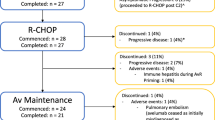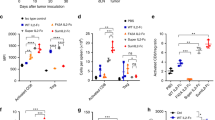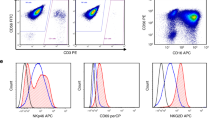Summary:
We determined the safety, immune activating effects, and potential efficacy of i.v. infusion of ex vivo interleukin-2 (IL-2) activated natural killer (NK) cells (part I) or IL-2 boluses (part II) during daily s.c. IL-2 administration following hematopoietic recovery from autologous transplantation. In all, 57 patients with relapsed lymphoma (n=29) or metastatic breast cancer (n=28) were enrolled. In part I of the study, 34 patients were enrolled at three dose levels of ex vivo IL-2-activated NK cells. Lymphaphereses were performed on days 28 and 42 of s.c. IL-2 administration. Following overnight ex vivo IL-2 activation of the pheresis product, the cells were reinfused the following day. In part II, 23 patients were enrolled at three dose levels of supplemental i.v. IL-2 bolus infusions, given on days 28 and 35 during s.c. IL-2 administration. Toxicities were generally mild, and no patient required hospitalization. Lytic function was markedly enhanced for fresh peripheral blood mononuclear cells (PBMNCs) obtained 1 day postinfusion of either IL-2-activated cells or IL-2 boluses. IL-2 boluses transiently increased the levels of IL-6, IFN-γ, TNF-α and IL1-β, with increases in IL-6 and IFN-γ being dose dependent. A total of 37 patients (19 patients with lymphoma, 18 with breast cancer) treated with an optimum dose of post-transplant immunotherapy (defined as having received 1.75 × 106 IU/m2/day of s.c. IL-2 plus at least one of the planned ex vivo IL-2-activated cell infusions/IL-2 boluses) could be matched with controls from the Autologous Blood and Marrow Transplant Registry database. The matched-pairs analysis demonstrated no improvement in disease outcomes of survival and relapse. We conclude that IL-2-activated cells/IL-2 boluses can be safely administered, generate PBMNCs with enhanced cytotoxicity against NK-resistant targets, and increase cytokine levels. With this dose and schedule of administration of IL-2, no improvement in patient disease outcomes was noted. Alternative strategies will be needed to exploit the immunotherapeutic potential of IL-2-activated NK cells.
This is a preview of subscription content, access via your institution
Access options
Subscribe to this journal
Receive 12 print issues and online access
$259.00 per year
only $21.58 per issue
Buy this article
- Purchase on Springer Link
- Instant access to full article PDF
Prices may be subject to local taxes which are calculated during checkout


Similar content being viewed by others
References
Weisdorf DJ, Verfaillie CM, Miller WJ et al. Autologous bone marrow versus non-mobilized peripheral blood stem cell transplantation for lymphoid malignancies: a prospective, comparative trial. Am J Hematol 1997; 54: 202–208.
Antman KH, Rowlings PA, Vaughan WP et al. High-dose chemotherapy with autologous hematopoietic stem-cell support for breast cancer in North America. J Clin Oncol 1992; 15: 1870–1879.
Verma UN, Areman E, Dickerson SA et al. Interleukin-2 activation of chemotherapy and growth factor-mobilized peripheral blood stem cells for generation of cytotoxic effectors. Bone Marrow Transplant 1995; 15: 199–206.
Miller JS, Tessmer-Tuck J, Pierson BA et al. Low dose subcutaneous interleukin-2 after autologous transplantation generates sustained in vivo natural killer cell activity. Biol Blood Marrow Transplant 1997; 3: 34–44.
Gottlieb DJ, Brenner MK, Heslop HE et al. A phase I clinical trial of recombinant interleukin 2 following high dose chemo-radiotherapy for haematological malignancy: applicability to the elimination of minimal residual disease. Br J Cancer 1989; 60: 610.
Blaise D, Olive D, Stoppa AM et al. Hematologic and immunologic effects of the systemic administration of recombinant interleukin-2 after autologous bone marrow transplantation. Blood 1990; 76: 1092–1097.
Higuchi CM, Thompson JA, Petersen FB et al. Toxicity and immunomodulatory effects of interleukin-2 after autologous bone marrow transplantation for hematologic malignancies. Blood 1991; 77: 2561–2568.
Caligiuri MA, Murray C, Soiffer RJ et al. Extended continuous infusion low-dose recombinant interleukin-2 in advanced cancer: prolonged immunomodulation without significant toxicity. J Clin Oncol 1991; 9: 2110–2119.
Caligiuri MA, Murray C, Robertson MJ et al. Selective modulation of human natural killer cells in vivo after prolonged infusion of low dose recombinant interleukin 2. J Clin Invest 1993; 91: 123–132.
Soiffer RJ, Murray C, Cochran K et al. Clinical and immunologic effects of prolonged infusion of low dose recombinant interleukin-2 after autologous and T-cell depleted allogeneic bone marrow transplantation. Blood 1992; 79: 517–526.
Weisdorf DJ, Anderson PM, Blazar BR et al. Interleukin-2 immediately after autologous bone marrow transplantation for acute lymphoblastic leukemia: a phase I study. Transplantation 1993; 55: 61–66.
Benyunes MC, Higuchi C, York A et al. Immunotherapy with interleukin-2 with or without lymphokine-activated killer cells after autologous bone marrow transplantation for malignant lymphoma: a feasibility trial. Bone Marrow Transplant 1995; 16: 283–288.
Lister J, Rybka WB, Donnenberg AD et al. Autologous peripheral blood stem cell transplantation and adoptive immunotherapy with activated natural killer cells in the immediate posttransplant period. Clin Cancer Res 1995; 6: 607–614.
Mazumder A . Experimental evidence of interleukin-2 activity in bone marrow transplantation. Cancer J Sci Am 1997; 3 (Suppl. 1): S37–S42.
Robinson N, Benyunes MC, Thompson JA et al. Interleukin-2 after autologous stem cell transplantation for hematologic malignancy: a phase I/II study. Bone Marrow Transplant 1997; 19: 435–442.
Benyunes MC, Massumoto C, York A et al. Interleukin-2 with or without lymphokine-activated killer cells as consolidative immunotherapy after autologous bone marrow transplantation for acute myelogenous leukemia. Bone Marrow Transplant 1993; 12: 159–163.
Meloni G, Vignetti M, Pogliani E et al. Interleukin-2 therapy in relapsed acute myelogenous leukemia. Cancer J Sci Am 1997; 3 (Suppl. 1): S43–S47.
Nagler A, Ackerstein A, Or R et al. Immunotherapy with recombinant human interleukin-2 and recombinant interferon-alpha in lymphoma patients post-autologous marrow or stem cell transplantation. Blood 1997; 89: 3951–3959.
Blaise D, Attal M, Pico JL et al. The use of a sequential high dose recombinant interleukin 2 regimen after autologous bone marrow transplantation does not improve the disease free survival of patients with acute leukemia transplanted in first complete remission. Leukemia Lymphoma 1997; 25: 469–478.
Van Besien K, Margolin K, Champlin R, Forman S . Activity of interleukin-2 in non-Hodgkin's lymphoma following transplantation of interleukin-2-activated autologous bone marrow or stem cells. Cancer J Sci Am 1997; 3 (Suppl. 1): S54–S58.
Meehan KR, Arun B, Gehan EA et al. Immunotherapy with interleukin-2 and alpha-interferon after IL-2-activated hematopoietic stem cell transplantation for breast cancer. Bone Marrow Transplant 1999; 23: 667–673.
Margolin KA, Van Besien K, Wright C et al. Interleukin-2-activated autologous bone marrow and peripheral blood stem cells in the treatment of acute leukemia and lymphoma. Biol Blood Marrow Transplant 1999; 5: 36–45.
DeMagalhaes-Silverman M, Donnenberg A, Lembersky B et al. Posttransplant adoptive immunotherapy with activated natural killer cells in patients with metastatic breast cancer. J Immunother 1999; 23: 154–160.
Blaise D, Attal M, Reiffers J et al. Randomized study of recombinant interleukin-2 after autologous bone marrow transplantation for acute leukemia in first complete remission. Eur Cytokine Net 2000; 11: 91–98.
Gravis G, Viens P, Vey N et al. Pilot study of immunotherapy with interleukin-2 after autologous stem cell transplantation in advanced breast cancers. Anticancer Res 2000; 20: 3987–3991.
Toh HC, McAfee SL, Sackstein R et al. High-dose cyclophosphamide + carboplatin and interleukin-2 (IL-2) activated autologous stem cell transplantation followed by maintenance IL-2 therapy in metastatic breast carcinoma – a phase II study. Bone Marrow Transplant 2000; 25: 19–24.
Toren A, Nagler A, Rozenfeld-Granot G et al. Amplification of immunological functions by subcutaneous injection of intermediate-high dose interleukin-2 for 2 years after autologous stem cell transplantation in children with stage IV neuroblastoma. Transplantation 2000; 70: 1100–1104.
Burns LJ, Weisdorf DJ, DeFor TE et al. Enhancement of the antitumor activity of a peripheral blood progenitor cell graft by mobilization with interleukin 2 plus granulocyte colony-stimulating factor in patients with advanced breast cancer. Exp Hematol 2000; 28: 96–103.
Meropol NJ, Porter M, Blumenson LE et al. Daily subcutaneous injection of low-dose interleukin 2 expands natural killer cells in vivo without significant toxicity. Clin Cancer Res 1996; 2: 669–677.
Snedecor G, Cocharn W . Statistical Methods. Iowa State University Press: Iowa, 1989.
Rosenberg SA, Lotze MT, Muul LM et al. A progress report on the treatment of 157 patients with advanced cancer using lymphokine-activated killer cells and interleukin-2 or high-dose interleukin-2 alone. N Engl J Med 1987; 316: 889–897.
Cooper MA, Fehniger TA, Turner SC et al. Human natural killer cells: a unique innate immunoregulatory role for the CD56bright subset. Blood 2001; 97: 3146–3151.
Gemlo BT, Palladino MA, Jaffe HS et al. Circulating cytokines in patients with metastatic cancer treated with recombinant interleukin 2 and lymphokine-activated killer cells. Cancer Res 1988; 48: 5864–5867.
Holter W, Goldman CK, Casabo L et al. Expression of functional IL-2 receptors by lipopolysaccharide and interferon-gamma stimulated human monocytes. J Immunol 1987; 138: 2917–2922.
Greenbaum LA, Horowitz JB, Woods A et al. Autocrine growth of CD4+ T cells. Differential effects of IL-1 on helper and inflammatory T cells. J Immunol 1988; 140: 1555–1560.
Mills CD . Molecular basis of ‘suppressor’ macrophages: arginine metabolism via the nitric oxide synthesis pathway. J Immunol 1991; 46: 2719–2723.
Tritarelli E, Rocca E, Testa U et al. Adoptive immunotherapy with high-dose interleukin-2: kinetics of circulating progenitors correlate with interleukin-6, granulocyte colony-stimulating factor level. Blood 1991; 77: 741–749.
Bonig H, Laws HJ, Wundes A et al. In vivo cytokine responses to interleukin-2 immunotherapy after autologous stem cell transplantation in children with solid tumors. Bone Marrow Transplant 2000; 26: 91–96.
Klingemann HG, Neerunjun J, Schwulera U, Ziltener HJ . Culture of normal and leukemic bone marrow in interleukin-2: analysis of cell activation, cell proliferation, and cytokine production. Leukemia 1993; 7: 1389–1393.
Sondel PM, Hank JA . Combination therapy with interleukin-2 and antitumor monoclonal antibodies. Cancer J Sci Am 1997; 3 (Suppl. 1): S121–S127.
Wigginton JM, Komschlies KL, Back TC et al. Administration of IL-12 with pulse interleukinn 2 and thhe rapid and complete eradication of murine renal carcinoma. J Natl Cancer Inst 1996; 88: 38–43.
Koh CY, Blazar BR, George T et al. Augmentation of antitumor effects by NK cell inhibitory receptor blockade in vitro and in vivo. Blood 2001; 97: 3132–3137.
Acknowledgements
We thank RN Juliette Gay and RN Cindy Steele for providing assistance in patient care, RN Roby Nicklow, RN Eva Gallagher, Victoria Johnson, and Melissa Walker for data management, MD Fred Sanchez for patient care, and Maurice Wolin and Priscilla Ayers (Chiron). LJB is the recipient of a Department of Defense grant, and is also supported by the Janie Lymphoma Research Fund and the Minnesota Medical Foundation. This work was supported in part by National Institute of Health Grant PO1-CA-65493 (JSM), R21CA78904 (DJW) and Grant M01-RR00400 from the National Center for Research Resources. We also acknowledge the support of the Bone Marrow Transplant Research Fund of the University of Minnesota and the Masonic Order of the Eastern Star.
Author information
Authors and Affiliations
Rights and permissions
About this article
Cite this article
Burns, L., Weisdorf, D., DeFor, T. et al. IL-2-based immunotherapy after autologous transplantation for lymphoma and breast cancer induces immune activation and cytokine release: a phase I/II trial. Bone Marrow Transplant 32, 177–186 (2003). https://doi.org/10.1038/sj.bmt.1704086
Received:
Accepted:
Published:
Issue Date:
DOI: https://doi.org/10.1038/sj.bmt.1704086
Keywords
This article is cited by
-
Natural killer cells: a promising immunotherapy for cancer
Journal of Translational Medicine (2022)
-
Challenges to the broad application of allogeneic natural killer cell immunotherapy of cancer
Stem Cell Research & Therapy (2022)
-
The Future of Natural Killer Cell Immunotherapy for B Cell Non-Hodgkin Lymphoma (B Cell NHL)
Current Treatment Options in Oncology (2022)
-
Exploring the NK cell platform for cancer immunotherapy
Nature Reviews Clinical Oncology (2021)
-
IL-15 superagonist N-803 improves IFNγ production and killing of leukemia and ovarian cancer cells by CD34+ progenitor-derived NK cells
Cancer Immunology, Immunotherapy (2021)



